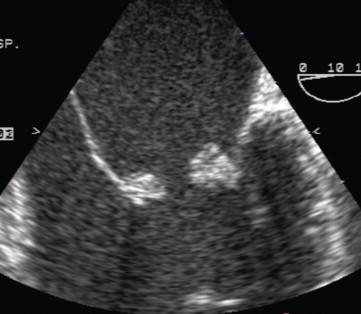Physical Address
304 North Cardinal St.
Dorchester Center, MA 02124
Immune-mediated systemic diseases can create valvular lesions, particularly systemic lupus erythematosus, primary antiphospholipid syndrome, rheumatoid arthritis, and ankylosing spondylitis.
Systemic lupus erythematosus is an immune complex–mediated inflammatory disease that can cause a variety of cardiac manifestations including valvular heart disease, coronary artery disease, myocarditis, and pericarditis. Valvular lesions, characterized by leaflet thickening and fibrosis, involve predominantly the aortic and mitral valves.
Echocardiography typically shows type IIIa dysfunction with leaflet thickening of the aortic and mitral valves. Valvular vegetations (Libman-Sacks endocarditis ) are commonly seen on the atrial side of the mitral valve and on the aortic side of the aortic valve. Typically, there are numerous vegetations with different sizes and irregular borders that produce heterogeneous echogenicity. Vegetations on both the anterior and posterior leaflets of the mitral valve, described as kissing vegetations, are characteristic ( Fig. 35-1 ). Finally, thrombotic vegetations can be observed in patients who have a hypercoagulable state. These vegetations are at risk of embolization and may cause cerebrovascular accidents.

The severity of valvular regurgitation, as seen on Doppler-color, is often mild to moderate and can be managed medically. Vegetations usually decrease in size or resolve with antiinflammatory therapy and an anticoagulation regimen. In rare occasions, advanced valvular lesions causing severe valvular regurgitation require surgical intervention.
Histological studies show that active vegetations are nonbacterial and have a central core of fibrinoid necrosis and fibroblastic proliferation surrounded by mononuclear and polymorphonuclear cells with fibrin and platelet deposits. In contrast, healed vegetations do not present with inflammatory cells and mainly appear as a central fibrosis surrounded by hyalinized or endothelialized thrombus formation.
Reconstructive valve surgery can be performed in selected cases. If the predominant lesion is posterior leaflet retraction, leaflet patch extension with glutaraldehyde-treated autologous pericardium followed by a remodeling annuloplasty should be performed. Resection of healed vegetations and thickened secondary chordae increases leaflet mobility. In the aortic position, valve replacement is the optimal surgical approach.
Become a Clinical Tree membership for Full access and enjoy Unlimited articles
If you are a member. Log in here